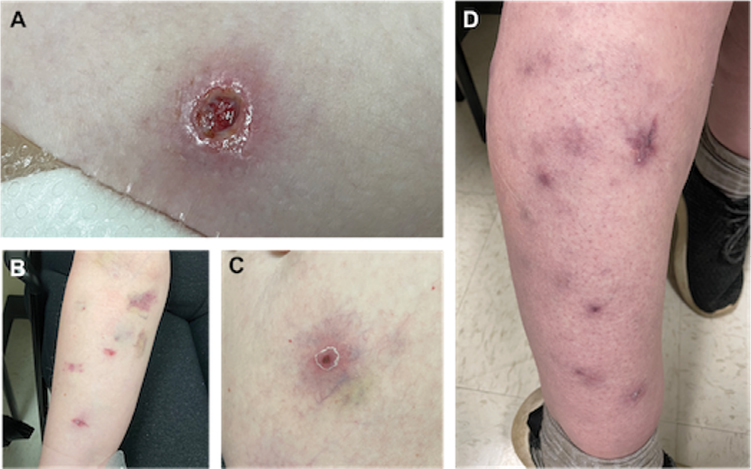Kuganya Nirmalarajah
Kuganya Nirmalarajah
1Sunnybrook Research Institute, Toronto, Ontario, Canada
1,✉,
Jonathon D Kotwa
Jonathon D Kotwa
1Sunnybrook Research Institute, Toronto, Ontario, Canada
1,
Hamza Mbareche
Hamza Mbareche
1Sunnybrook Research Institute, Toronto, Ontario, Canada
1,
Patryk Aftanas
Patryk Aftanas
1Sunnybrook Research Institute, Toronto, Ontario, Canada
1,
Xi Z Zhong
Xi Z Zhong
2Sinai Health System, Toronto, Ontario, Canada
2,
Natalie G Bell
Natalie G Bell
1Sunnybrook Research Institute, Toronto, Ontario, Canada
1,
Shiva Barati
Shiva Barati
2Sinai Health System, Toronto, Ontario, Canada
2,
Emily Chien
Emily Chien
1Sunnybrook Research Institute, Toronto, Ontario, Canada
1,
Gloria Crowl
Gloria Crowl
2Sinai Health System, Toronto, Ontario, Canada
2,
Amna Faheem
Amna Faheem
2Sinai Health System, Toronto, Ontario, Canada
2,
Lubna Farooqi
Lubna Farooqi
2Sinai Health System, Toronto, Ontario, Canada
2,
Ryan J Hiebert
Ryan J Hiebert
1Sunnybrook Research Institute, Toronto, Ontario, Canada
1,
Alainna J Jamal
Alainna J Jamal
2Sinai Health System, Toronto, Ontario, Canada
2,
Kevin Katz
Kevin Katz
3North York General Hospital, Toronto, Ontario, Canada
3,
Saman Khan
Saman Khan
2Sinai Health System, Toronto, Ontario, Canada
2,
Robert A Kozak
Robert A Kozak
1Sunnybrook Research Institute, Toronto, Ontario, Canada
1,
Angel X Li
Angel X Li
2Sinai Health System, Toronto, Ontario, Canada
2,
Reena Lovinsky
Reena Lovinsky
4Scarborough Health Network, Toronto, Ontario, Canada
4,
David Rose
David Rose
4Scarborough Health Network, Toronto, Ontario, Canada
4,
Finlay Maguire
Finlay Maguire
5Faculty of Computer Science, Dalhousie University, Halifax, Nova Scotia, Canada
5,
Mohammad Mozafarihashjin
Mohammad Mozafarihashjin
2Sinai Health System, Toronto, Ontario, Canada
2,
Sheridan JC Baker
Sheridan JC Baker
6Michael G DeGroote Institute for Infectious Disease Research, McMaster University, Hamilton, Ontario, Canada
7Department of Biochemistry and Biomedical Sciences, McMaster University, Hamilton, Ontario, Canada
6,7,
Hooman Derakhshani
Hooman Derakhshani
7Department of Biochemistry and Biomedical Sciences, McMaster University, Hamilton, Ontario, Canada
8Farncombe Family Digestive Health Research Institute, McMaster University, Hamilton, Ontario, Canada
9Department of Medicine, McMaster University, Hamilton, Ontario, Canada
7,8,9,
Laura Rossi
Laura Rossi
8Farncombe Family Digestive Health Research Institute, McMaster University, Hamilton, Ontario, Canada
9Department of Medicine, McMaster University, Hamilton, Ontario, Canada
8,9,
Jalees A Nasir
Jalees A Nasir
6Michael G DeGroote Institute for Infectious Disease Research, McMaster University, Hamilton, Ontario, Canada
7Department of Biochemistry and Biomedical Sciences, McMaster University, Hamilton, Ontario, Canada
6,7,
Emily M Panousis
Emily M Panousis
6Michael G DeGroote Institute for Infectious Disease Research, McMaster University, Hamilton, Ontario, Canada
7Department of Biochemistry and Biomedical Sciences, McMaster University, Hamilton, Ontario, Canada
6,7,
Ahmed N Draia
Ahmed N Draia
6Michael G DeGroote Institute for Infectious Disease Research, McMaster University, Hamilton, Ontario, Canada
7Department of Biochemistry and Biomedical Sciences, McMaster University, Hamilton, Ontario, Canada
6,7,
Aimee Paterson
Aimee Paterson
2Sinai Health System, Toronto, Ontario, Canada
2,
Jeff Powis
Jeff Powis
10Michael Garron Hospital, Toronto, Ontario, Canada
10,
Christopher Kandel
Christopher Kandel
10Michael Garron Hospital, Toronto, Ontario, Canada
10,
Renée Schryer
Renée Schryer
1Sunnybrook Research Institute, Toronto, Ontario, Canada
1,
Altynay Shigayeva
Altynay Shigayeva
2Sinai Health System, Toronto, Ontario, Canada
2,
Maureen Taylor
Maureen Taylor
10Michael Garron Hospital, Toronto, Ontario, Canada
10,
Natalie Wilson
Natalie Wilson
1Sunnybrook Research Institute, Toronto, Ontario, Canada
1,
Jeremiah Yarmie
Jeremiah Yarmie
1Sunnybrook Research Institute, Toronto, Ontario, Canada
1,
Winfield Yim
Winfield Yim
1Sunnybrook Research Institute, Toronto, Ontario, Canada
1,
Michael G Surette
Michael G Surette
6Michael G DeGroote Institute for Infectious Disease Research, McMaster University, Hamilton, Ontario, Canada
9Department of Medicine, McMaster University, Hamilton, Ontario, Canada
6,9,
Andrew G McArthur
Andrew G McArthur
6Michael G DeGroote Institute for Infectious Disease Research, McMaster University, Hamilton, Ontario, Canada
7Department of Biochemistry and Biomedical Sciences, McMaster University, Hamilton, Ontario, Canada
6,7,
Allison J McGeer
Allison J McGeer
2Sinai Health System, Toronto, Ontario, Canada
11Faculty of Medicine, University of Toronto, Toronto, Ontario, Canada
2,11,
Samira Mubareka
Samira Mubareka
1Sunnybrook Research Institute, Toronto, Ontario, Canada
11Faculty of Medicine, University of Toronto, Toronto, Ontario, Canada
1,11
1Sunnybrook Research Institute, Toronto, Ontario, Canada
2Sinai Health System, Toronto, Ontario, Canada
3North York General Hospital, Toronto, Ontario, Canada
4Scarborough Health Network, Toronto, Ontario, Canada
5Faculty of Computer Science, Dalhousie University, Halifax, Nova Scotia, Canada
6Michael G DeGroote Institute for Infectious Disease Research, McMaster University, Hamilton, Ontario, Canada
7Department of Biochemistry and Biomedical Sciences, McMaster University, Hamilton, Ontario, Canada
8Farncombe Family Digestive Health Research Institute, McMaster University, Hamilton, Ontario, Canada
9Department of Medicine, McMaster University, Hamilton, Ontario, Canada
10Michael Garron Hospital, Toronto, Ontario, Canada
11Faculty of Medicine, University of Toronto, Toronto, Ontario, Canada
Copyright © 2022, Association of Medical Microbiology and Infectious Disease Canada (AMMI Canada)



























